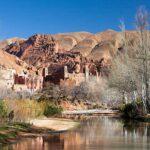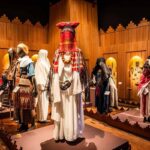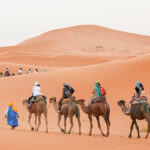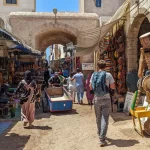Nestled in the heart of Morocco’s Rif Mountains lies a surreal vision, almost a mirage in its azure brilliance. Chefchaouen, fondly known as the Blue Pearl, is not just a city but a realm of dreams painted in countless shades of blue. This enchanting city, with its Medina draped in cerulean, cobalt, and sapphire, beckons travelers from all corners of the globe, offering a glimpse into a world where time seems to stand still, and every alley tells a story.
Table of contents
- The Lure of Chefchaouen: Is This Moroccan Gem Worth the Journey?
- Navigating the Blue Alleys: Balancing Tourism and Authenticity
- Time Stands Still: How Long to Soak in Chefchaouen’s Magic?
- A Palette of Blue: Unraveling the Mystery Behind Chefchaouen’s Colors
- Culinary Delights and Local Crafts: Experiencing Chefchaouen’s Culture
- Beyond the Blue: Day Trips and Adventures Around Chefchaouen
- Departing the Dreamy Blue City
The Lure of Chefchaouen: Is This Moroccan Gem Worth the Journey?

Historical and Cultural Significance
Chefchaouen is not just a picturesque town; it’s a rich tapestry of history and culture. Founded in 1471 as a small fortress, this town has been a melting pot of cultures, including Berber, Moorish, and Spanish influences, creating a unique cultural identity. The city’s famed blue walls, originally a tradition among the Jewish community, symbolize Chefchaouen’s unique heritage. This intertwining of cultures is evident in its inhabitants’ architecture, cuisine, and daily life, making Chefchaouen a living museum of Moroccan history.
Testimonials from Visitors
Travelers who have wandered through Chefchaouen’s labyrinthine streets invariably speak of its almost mystical charm. Many describe it as a tranquil escape, noting the calming effect of its blue-hued streets. “Walking through Chefchaouen is like moving inside a dream,” says Maria, a visitor from Spain. Another traveler, John from Australia, remarks, “It’s not just the colors; it’s the warmth of the people and the serenity of the place that captivates you.” These testimonials highlight not just the visual beauty of Chefchaouen but the overall experience of visiting this unique city.
Key Attractions
The main attraction of Chefchaouen is undoubtedly its Medina, a beautifully preserved old city with winding alleys and blue-washed buildings. Key landmarks include the Outa el Hammam Square with the grand Kasbah, a fortress and dungeon, and the Great Mosque, known for its octagonal minaret. For those seeking a panoramic view of the city, the hike to the Spanish Mosque provides a breathtaking vista, especially at sunset. The Ras Elma River, the source of the city’s fresh mountain water, is another attraction, offering a scenic backdrop for a leisurely walk. In addition, the local markets brimming with crafts, textiles, and unique souvenirs offer an authentic taste of Moroccan life.
Chefchaouen’s allure lies not just in its aesthetic beauty but in the stories, history, and experiences it offers. This blue city is more than worth the journey—it’s a destination that captures the heart and stays in the memory long after you’ve left its enchanting streets.
Navigating the Blue Alleys: Balancing Tourism and Authenticity

Is Chefchaouen too touristy?
Chefchaouen, with its Instagram-famous blue streets, has seen a significant increase in tourism over recent years. This surge of interest has brought concerns about the city losing its authentic charm. Visitors often wonder if the influx of tourists has overshadowed the genuine Moroccan experience that Chefchaouen promises. While it’s true that popular spots in the city can feel crowded, especially during peak seasons, Chefchaouen still retains much of its original allure. The city has managed to preserve its cultural integrity, which is evident in the local customs, traditional markets, and the daily life of its residents that continue amidst the tourist bustle.
Finding the Balance
The key to experiencing the authentic Chefchaouen is stepping off the beaten path. Beyond the main squares and the most photographed streets, there are quieter alleys, family-run cafes, and artisan workshops where the real heartbeat of the city can be felt. Engaging with locals, trying traditional Moroccan dishes at local restaurants, and exploring the city during off-peak hours can provide a more authentic experience.
Visitors can also contribute to maintaining Chefchaouen’s authenticity by respecting local customs and traditions. This includes dressing modestly, being mindful of photography etiquette, and supporting local businesses rather than tourist-centric shops. Such respectful tourism ensures a mutually beneficial experience, preserving the city’s cultural heritage while allowing visitors to enjoy its unique charm.
Moreover, staying in traditional accommodations like Riads (Moroccan guesthouses) and participating in local experiences like cooking classes or guided cultural tours can further deepen the understanding and appreciation of Chefchaouen’s rich culture and history.
While Chefchaouen has adapted to accommodate its popularity among tourists, it has retained its soul. The city continues to be a vibrant, living testament to Moroccan culture, offering an authentic experience to those who seek it. Balancing tourism and authenticity is not just the city’s responsibility but also that of the visitors, who play a crucial role in preserving the essence of this blue gem.
Time Stands Still: How Long to Soak in Chefchaouen’s Magic?
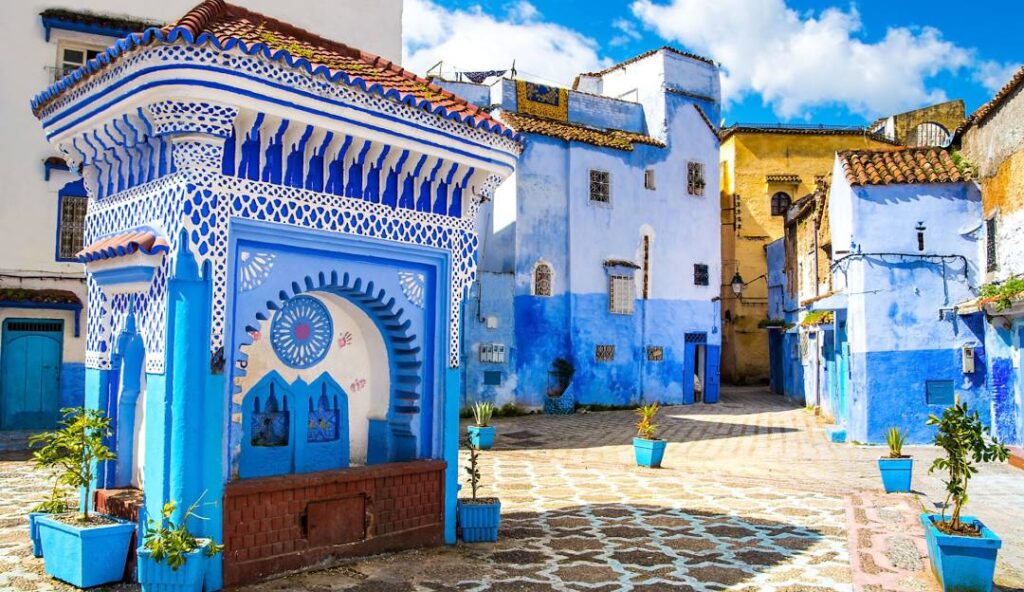
Suggested Itineraries
- One-Day Visit: If you’re short on time, a day trip can cover the highlights. Start early with a stroll through the Medina, visit the Kasbah Museum, and enjoy a traditional Moroccan lunch at a local café. In the afternoon, explore the artisanal market for unique souvenirs, then hike to the Spanish Mosque for a sunset view.
- Two-Day Trip: You can delve deeper into Chefchaouen’s charm over two days. The first day can include the activities from the one-day itinerary. On the second day, visit the Ras Elma River, explore hidden alleys, and perhaps engage in a cultural or cooking workshop. Dine at a local restaurant to experience authentic Moroccan cuisine.
- Three-Day Exploration: A three-day stay allows for a relaxed pace. In addition to the activities mentioned, you can take day tours to nearby attractions like the Akchour Waterfalls. Spend more time interacting with locals, visiting galleries, and enjoying leisurely meals at various local cafes.
Combining Chefchaouen with Morocco’s Sahara Desert and
Embarking on a 6-day ‘Desert Tour from Marrakech to Chefchaouen’ is an extraordinary journey that blends Morocco’s diverse landscapes and cultures. This tour allows you to experience the bustling energy of Marrakech before transitioning to the awe-inspiring vastness of the Moroccan Sahara Desert. Here, you can witness the breathtaking sunrise over the dunes, perhaps even from the back of a camel, and experience a night under the stars in a traditional Berber camp. The journey continues to Fes, one of the best-preserved medieval cities in the world, where you can immerse yourself in the rich history and vibrant culture. The final destination is the serene blue city of Chefchaouen, where the pace slows, and you can reflect on the myriad of experiences you’ve encountered along the way. This 6-day tour is not just a trip but a mosaic of diverse Moroccan landscapes, from the bustling souks of Marrakech to the tranquil alleys of Chefchaouen, creating a well-rounded and unforgettable Moroccan adventure.
Best Times to Visit Chefchaouen
Chefchaouen is enchanting year-round, but the best times to visit Chefchaouen are spring (April to June) and fall (September to November). These periods offer mild weather, making it comfortable to explore the city. Summers can be pretty hot, and mild winters may have rainy days.
Accommodation Options
Chefchaouen offers a range of accommodations to suit various preferences and budgets:
- Riads and Guesthouses: For an authentic experience, stay in a traditional Moroccan Riad. These guesthouses are often beautifully decorated, offering a personal touch and a deeper insight into Moroccan culture.
- Hotels: Various hotels range from budget-friendly options to more luxurious choices. Many hotels are located within or close to the medina, providing easy access to the city’s attractions.
- Hostels: For solo travelers or those on a limited budget, hostels are an excellent option. They offer basic amenities and a chance to meet fellow travelers.
- Airbnb and Rentals: For a more private or unique stay, consider renting an apartment or a house. This option can be especially appealing to families or groups.
Spending time in Chefchaouen can be as short as a day trip or as long as a 3-day stay. The duration of your visit may depend on your itinerary and interests. Still, regardless of how long you stay, Chefchaouen is sure to leave an indelible mark with its tranquil beauty and timeless charm.
A Palette of Blue: Unraveling the Mystery Behind Chefchaouen’s Colors

Historical Reasons for the Blue Color
The origins of Chefchaouen’s blue walls are as mystical as the city itself. One popular theory is that blue paint was introduced by Jewish refugeesfrom Spain during the 15th century, who considered blue a symbol of the sky and heaven, thus reflecting their spiritual beliefs. Another theory suggests that the blue serves a practical purpose: repelling mosquitoes and keeping the houses cool during the hot summer months. The tradition of painting the city in shades of blue has been maintained over the decades, becoming an integral part of Chefchaouen’s identity and a beautiful remnant of its historical past.
Cultural Significance
In Chefchaouen, the color blue transcends mere aesthetics; it holds a more profound cultural significance. Blue is seen as a color of peace, wisdom, and serenity, qualities deeply embedded in the city’s daily life. It also represents the city’s harmonious relationship with nature, mirroring the sky and surrounding mountains. For the residents, maintaining the blue is not just about preserving a tourist attraction; it is about upholding a tradition that has become a part of their cultural fabric.
Interviews with Locals
To gain deeper insight, conversations with locals reveal a personal connection to the blue city. Hamid, a lifelong resident, says, “The blue streets are a part of who we are. They remind us of our history and our ancestors’ resilience.” Another local, Amina, a shop owner, adds, “The blue walls bring a sense of calm and belonging. It’s not just a color but a feeling you can’t find anywhere else.” These sentiments echo the locals’ pride and attachment to their unique city, showcasing how the blue of Chefchaouen is more than a visual wonder; it’s a living, breathing part of its community.
Through its blue walls, Chefchaouen tells a story steeped in history, enriched by culture, and cherished by its inhabitants. The city’s palette of blue draws visitors from around the world and continues to be a source of identity and pride for those who call it home.
Culinary Delights and Local Crafts: Experiencing Chefchaouen’s Culture
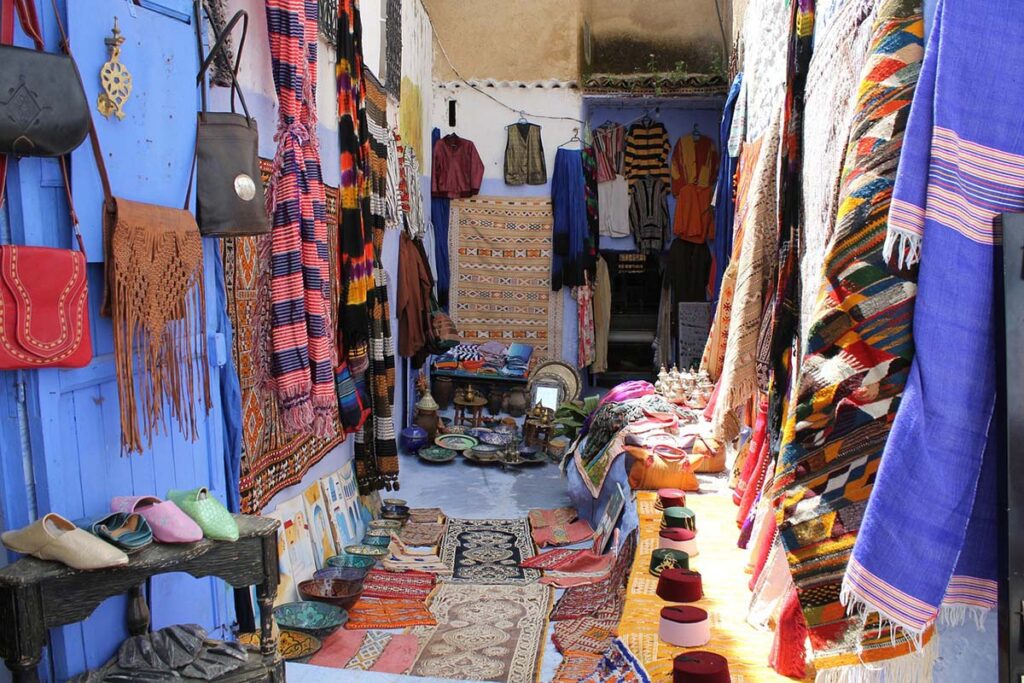
Guide to Local Cuisine
Chefchaouen’s culinary scene offers a delightful fusion of traditional Moroccan flavors with unique local twists. A must-try is the ‘Tagine,’ a slow-cooked stew that comes in various flavors, including lamb, chicken, and vegetarian options, infused with rich spices like saffron, cumin, and coriander. Another local specialty is ‘Couscous,’ often served on Fridays, a tradition in Moroccan households. Indulge in ‘Rghaif,’ a Moroccan flatbread, often paired with local honey or goat cheese for breakfast or a snack.
For those with a sweet tooth, ‘Baklava’ and ‘Makrout,’ both sweet pastries filled with nuts or dates, are a delight. Remember to try the Moroccan mint tea, a symbol of warm hospitality and an integral part of Chefchaouen’s culture, often served with a generous helping of sugar.
Spotlight on Artisan Crafts and Shopping
Chefchaouen is not just about its picturesque streets; it’s also a haven for lovers of artisan crafts. The city’s Medina is dotted with small shops and Souks where you can find a wide range of handmade goods. Wool garments and woven blankets are popular, often dyed in vibrant colors using traditional methods. Leather goods, such as bags and belts, are also common, showcasing the skill of local artisans.
Pottery and ceramics from Chefchaouen are unique, often characterized by intricate designs and a rich blue color that mirrors the city’s streets. Jewelry, especially silver pieces, is another find, often adorned with beautiful Berber designs.
While shopping, engaging with the artisans offers a glimpse into their craftsmanship and the traditions behind their work. It’s also a way to support the local economy, ensuring these age-old skills are preserved and passed on.
In Chefchaouen, every meal is a feast for the senses, and every shopping experience is a journey into the heart of Moroccan craftsmanship. Whether savoring the local cuisine or browsing the vibrant markets, you’re experiencing the essence of Chefchaouen’s culture.
Beyond the Blue: Day Trips and Adventures Around Chefchaouen
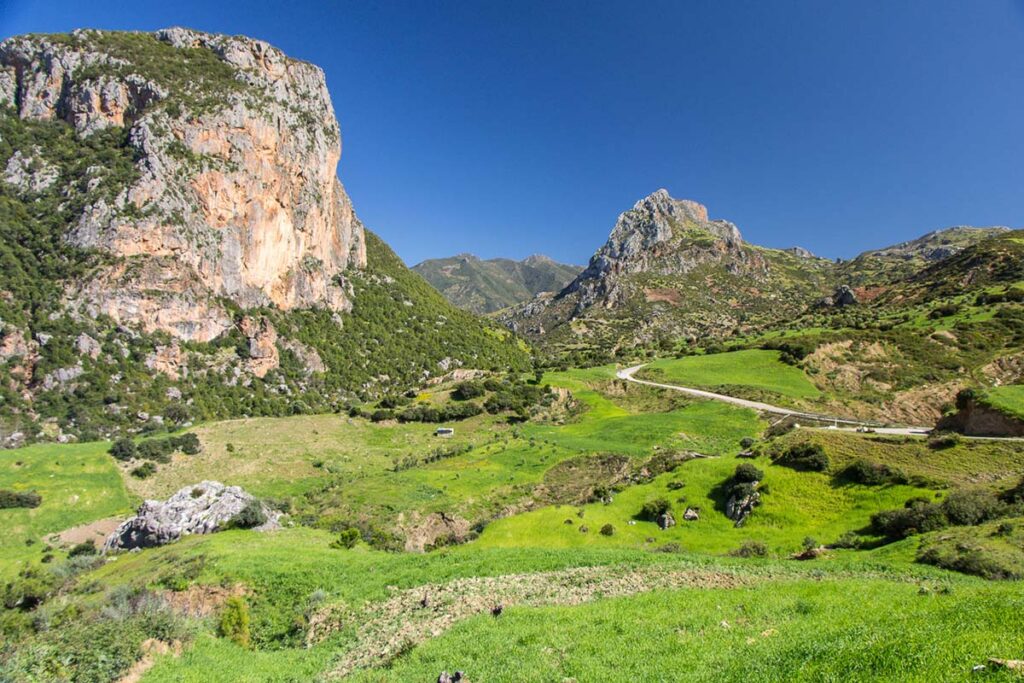
Nearby Attractions and Activities
While Chefchaouen itself is a treasure trove of experiences, the area surrounding the city offers numerous opportunities for exploration and adventure:
- Akchour Waterfalls: Located in the Talassemtane National Park, a short drive from Chefchaouen, the Akchour Waterfalls are a natural wonder. Visitors can enjoy a scenic hike through lush landscapes to reach these stunning falls. The area also features the God’s Bridge, a natural rock arch that offers spectacular photo opportunities.
- Tetouan and the Mediterranean Coast: A day trip to the city of Tetouan and the nearby Mediterranean coast is perfect for those looking to combine cultural exploration with beach relaxation. Tetouan is a UNESCO World Heritage site known for its Andalusian-influenced architecture and vibrant medina. The Mediterranean coast, particularly the beaches of Martil and Cabo Negro, offers a refreshing escape with beautiful seaside views.
- Ouazzane: For a cultural excursion, Ouazzane is an ideal destination. Known for its religious significance and beautiful olive groves, it offers a different perspective on Moroccan culture and spirituality.
Nature Trails and Hikes
The Rif Mountains surrounding Chefchaouen provide a paradise for nature lovers and hiking enthusiasts:
- Talassemtane National Park: This national park offers a range of hiking trails suitable for beginners and experienced hikers alike. The Talassemtane Park is home to diverse flora and fauna, and the trails provide breathtaking views of the Rif Mountains and valleys.
- Jebel el-Kelaa Trek: For a more challenging adventure, the Jebel el-Kelaa trek leads to the summit of one of the highest peaks in the Rif Mountains. This hike offers panoramic views of the region and is a rewarding experience for those up for the challenge.
- Ras Elma: For a lighter walk, the path along the Ras Elma river, just outside the city, is peaceful and picturesque, perfect for a leisurely stroll.
These excursions around Chefchaouen not only showcase the natural beauty of Morocco but also offer a chance to immerse yourself in the region’s diverse landscapes and rich cultural tapestry. Whether you’re seeking adventure, relaxation, or cultural enrichment, the area around Chefchaouen has something to offer every traveler.
Departing the Dreamy Blue City
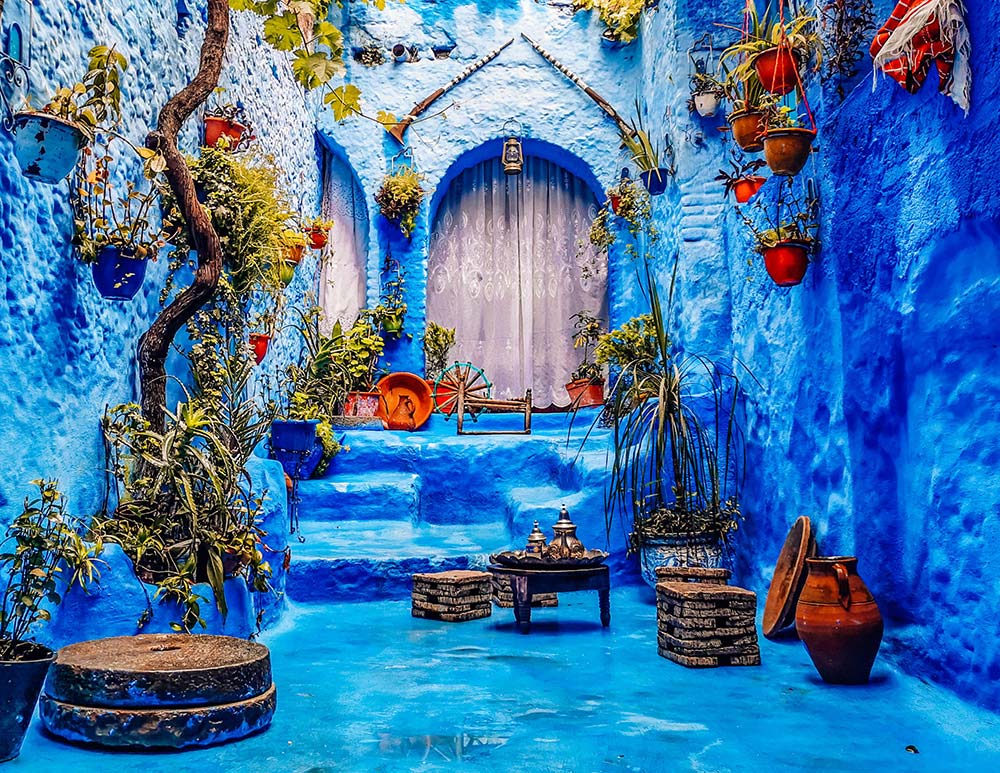
As your journey in Chefchaouen comes to a close, you carry more than just memories of azure streets and scenic views. The experience of wandering through the blue-washed alleys of Chefchaouen is akin to stepping into a living canvas, where every corner paints a picture of tranquility and time-honored traditions. The city’s serene atmosphere, coupled with the warmth of its people, leaves a lasting impression that resonates deep within.
Reflecting on your visit to Chefchaouen, it’s the small moments that stand out:
- The aroma of freshly brewed mint tea.
- The vibrant hues of textiles in the local market.
- The echo of the call to prayer at sunset.
- The simple joy of meandering through streets that feel like a dream.
Chefchaouen is more than just a destination; it’s a sensory journey that entwines the beauty of nature with the richness of Moroccan culture.
As you depart from Chefchaouen, take souvenirs and photographs with you and the inspiration to explore further. Morocco is a land of contrasts and diversity, offering many experiences beyond the Blue City. From the bustling souks of Marrakech to the vast expanse of the Sahara, from the historic streets of Fes to the serene Mediterranean coast, each destination has its own story to tell.
Chefchaouen is a reminder of the beauty that lies in simplicity and the peace that can be found in slowing down. It encourages us to explore with an open heart, to appreciate the beauty in the details, and to connect with cultures different from our own. So, as you leave Chefchaouen behind, let it be with a sense of gratitude and a renewed curiosity to discover the many wonders that Morocco, and indeed the world, has to offer.






